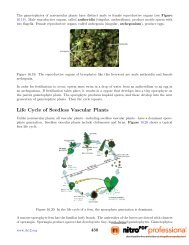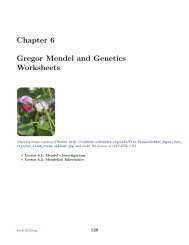Chapter 23 The Circulatory, Respiratory, Digestive, and Excretory ...
Chapter 23 The Circulatory, Respiratory, Digestive, and Excretory ...
Chapter 23 The Circulatory, Respiratory, Digestive, and Excretory ...
You also want an ePaper? Increase the reach of your titles
YUMPU automatically turns print PDFs into web optimized ePapers that Google loves.
Figure <strong>23</strong>.17: Cigarette warning labels unveiled on 6/21/2011 by the U.S. Food <strong>and</strong> Drug Administration.<br />
Lesson Summary<br />
• Respiration is the process in which gases are exchanged between the body <strong>and</strong> the outside air. <strong>The</strong><br />
lungs <strong>and</strong> other organs of the respiratory system bring oxygen into the body <strong>and</strong> release carbon<br />
dioxide into the atmosphere.<br />
• Respiration begins with ventilation, the process of moving air into <strong>and</strong> out of the lungs. Gas exchange<br />
in the lungs takes place in across the thin walls of pulmonary arteries in tiny air sacs called alveoli.<br />
Oxygenated blood is transported by the circulatory system from lungs to tissues throughout the<br />
body. Gas exchange between blood <strong>and</strong> body cells occurs across the walls of peripheral capillaries.<br />
• Gas exchange helps maintain homeostasis by supplying cells with oxygen, carrying away carbon<br />
dioxide waste, <strong>and</strong> maintaining proper pH of the blood.<br />
• Breathing occurs due to repeated contractions of a large muscle called the diaphragm. <strong>The</strong> rate of<br />
breathing is regulated by the brain stem. It monitors the level of carbon dioxide in the blood <strong>and</strong><br />
triggers faster or slower breathing as needed to keep the level within a narrow range.<br />
• Diseases of the respiratory system include asthma, pneumonia, <strong>and</strong> emphysema.<br />
Lesson Review Questions<br />
Recall<br />
1. What is respiration? What is ventilation?<br />
2. How is respiration different from cellular respiration?<br />
3. Outline the pathway of a breath of air from the nose to the alveoli.<br />
4. Describe how pulmonary gas exchange occurs.<br />
5. Identify three diseases of the respiratory system, <strong>and</strong> state what triggers or causes each disease.<br />
www.ck12.org 704





